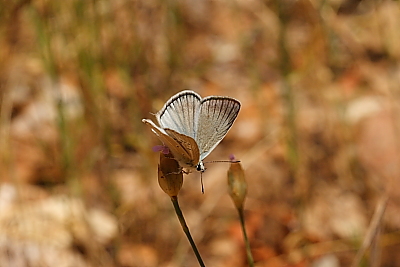
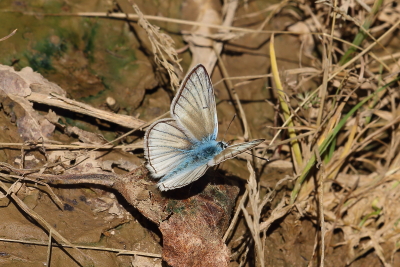
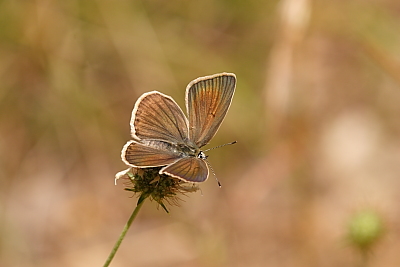
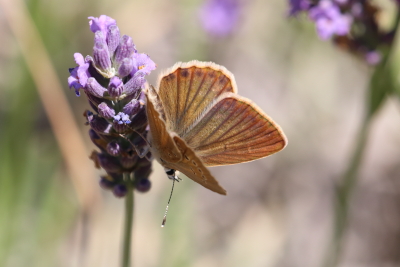

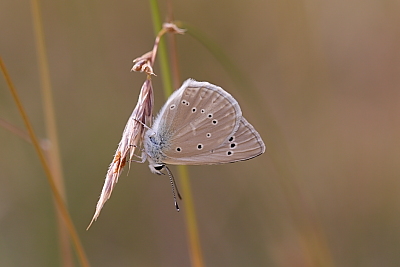
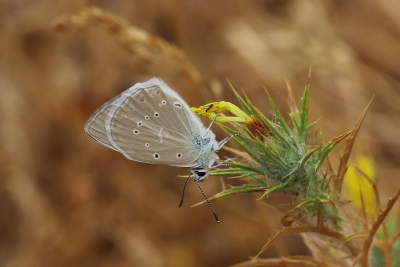
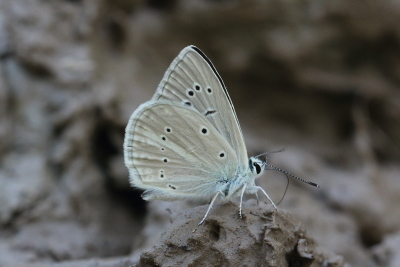

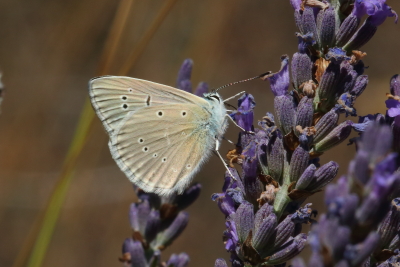
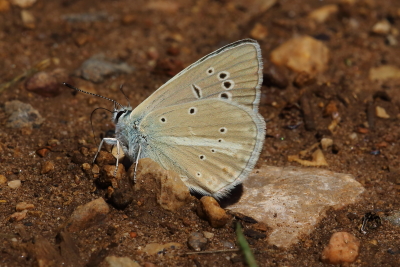
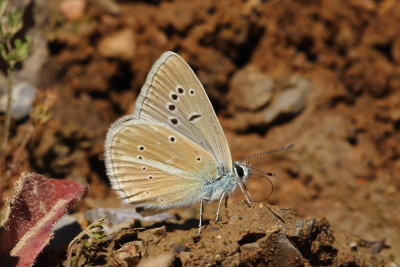
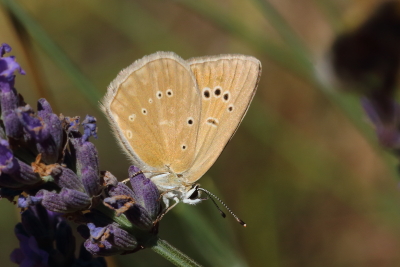
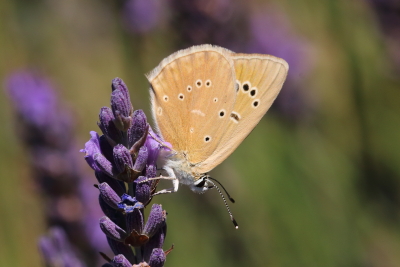
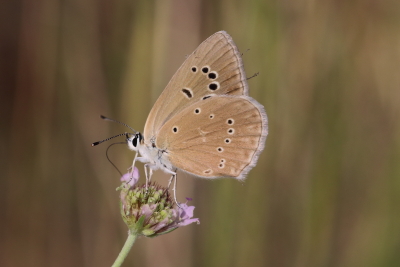
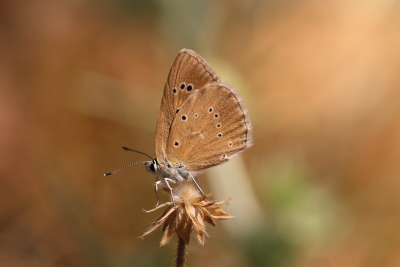
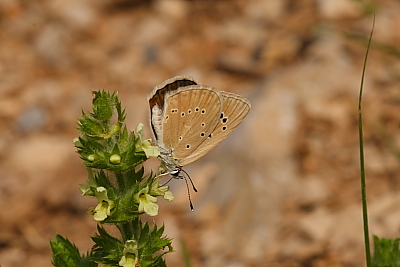
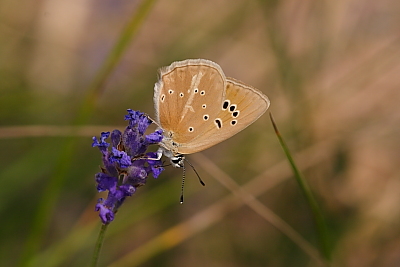
Furry Blue (Polyommatus dolus)
2024 photographs highlighted in yellow. Click on any photograph to go to an enlarged picture, or simply scroll down the page.
|
A quite uncommon blue (in Var) that I have only encountered in three locations. Books sometimes show dolus with a clear unh white streak (male only) which is well-defined and rather similar to the streak of the Damon Blue (P. damon), but this can be vestigial or absent in southern France and this has certainly been true for many, if not most, of the specimens I have seen in Var. The subspecies vittatus which is found only in the Cévennes (some examples on this page), has the white streak and this does appear, from my limited experience, to be consistent.
I find that the unh ground colour of the nominate species male is a rather pure grey with a brownish tinge, while the vittatus unh is a rather deeper brown.
When I first saw dolus, it looked like the Provence Chalk-hill blue (P. hispanus) at first sight (it was too early for coridon to have emerged), especially as it was in an area where both hispanus and coridon were common, but didn’t look quite as silvery. I saw several males and females, all restricted to one very small area. |
I revisited this site again in July 2003, but saw not even one specimen, although 2003 was exceptionally hot and it did seem to have been a very bad year for blues generally. In July 2004 I met up with Tim Cowles and Guy Padfield at the same site and dolus put in an appearance, and I suggest you visit Guy's excellent site (links page) for photographs of these dolus from 2004.
I saw a single male and female at another site nearby in 2006, suggesting that its range is wider. Since then I have only seen dolus at one other location in western Var where I saw one male in early July 2011 but in mid-July 2013, this being the peak of the flight period, it was pleasing to see a dozen or so individuals.
Quite why it was called Furry, I have no idea. However, it has been kindly pointed out to me by Peter Groenendijk (www.anythingbutcommon.nl) that the basal region of the male upperside forewing is indeed rather furry. I see the upperside rarely so had not noticed this.
This species was previously known as Agrodiaetus dolus. |
| ref | sex |
observations |
alt. m |
| 33670 | M | a male upperside, showing the very pale silvery-blue, almost white colour of the upperside. | 450 |
| 43807 | M | a male of the subspecies vittatus, where the upperside colour is even paler than that of the nominate form, and almost completely white. The vittatus veins are also very prominent. It is a species that usually settles with closed wings, so opportunities to get any sort of upperside shot are rare. 43829 is the underside. | 850 |
| 33702 | F | a female, a dull brown with virtually no markings. | 680 |
| 46531 | F | a female with very prominent black veins and uph submarginal black spots. | 680 |
| 33715 | M | a male underside, with the wings slightly offset to show a glimpse of the pale upperside. This appears to be rather browner than the norm. The marginal markings, which are usually ghosted, appear quite well defined on 33175. | 680 |
| 33775 | M | a male underside, typically pale, from my limited experience. The white streak is very faint. | 680 |
| 43568 | M | a male of the nominate species. The white streak is so indistinct as to be almost invisible. | 640 |
| 46426 | M | a male with a very pale ground colour such that the white streak is poorly contrasted. | 680 |
| 46427 | M | two males, both a very clean pale grey, the one on the left having a rather mottled white streak such that it is hardly discernible, the one on the right having a more normal and more visible white streak. The one on the right is in fact the same as 46426. | 680 |
| 46497 | M | a male with a more brown-grey ground colour and no sign of even a vestigial white streak. | 680 |
| 43786 | M | a male of the subspecies vittatus. It a rather deep brown, showing the white streak quite prominently. | 950 |
| 43829 | M | another male of the subspecies vittatus, a deeper brown than 43786 with a very prominent white streak. | 850 |
| 46527 | F | a female, with a rather pale brown ground colour and a vestigial white streak only apparent on close inspection. | 680 |
| 46513 | F | a female, with a rather pale ground colour, no trace of a white streak and rather ghosted unh marginal markings. | 680 |
| 46447 | F | a female, with a rather darkish grey-brown ground colour, rather dirty on the unf submarginal region. It is not clear what the darkish protrusion on the forewing actually is, but it was clearly attached to the forewing and did not seem to impede its flight. | 680 |
| 44274 | F | a female of the nominate species, a very deep rich chocolate brown without even a vestigial trace of a white streak. | 680 |
| 33733 | F | a female underside, the offset wings showing a very deep brown upperside colour. The white streak is vestigial and almost non-existent. | 680 |
| 33755 | F | another female underside, but the white streak is rather more distinct. | 680 |
43568_male_Bouches-du-Rhône_29Jun17